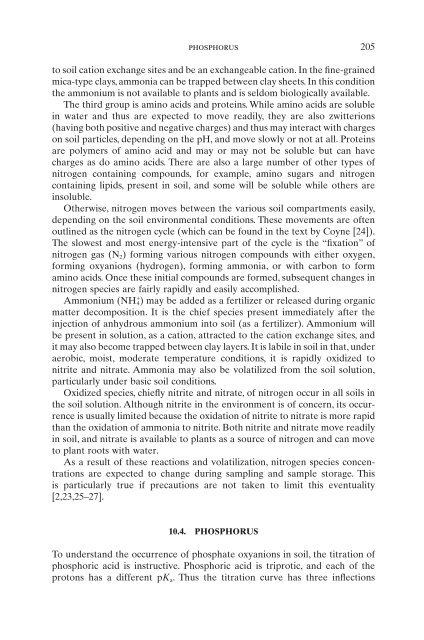Introduction to Soil Chemistry
Introduction to Soil Chemistry
Introduction to Soil Chemistry
You also want an ePaper? Increase the reach of your titles
YUMPU automatically turns print PDFs into web optimized ePapers that Google loves.
phosphorus 205<br />
<strong>to</strong> soil cation exchange sites and be an exchangeable cation. In the fine-grained<br />
mica-type clays, ammonia can be trapped between clay sheets. In this condition<br />
the ammonium is not available <strong>to</strong> plants and is seldom biologically available.<br />
The third group is amino acids and proteins. While amino acids are soluble<br />
in water and thus are expected <strong>to</strong> move readily, they are also zwitterions<br />
(having both positive and negative charges) and thus may interact with charges<br />
on soil particles, depending on the pH, and move slowly or not at all. Proteins<br />
are polymers of amino acid and may or may not be soluble but can have<br />
charges as do amino acids. There are also a large number of other types of<br />
nitrogen containing compounds, for example, amino sugars and nitrogen<br />
containing lipids, present in soil, and some will be soluble while others are<br />
insoluble.<br />
Otherwise, nitrogen moves between the various soil compartments easily,<br />
depending on the soil environmental conditions. These movements are often<br />
outlined as the nitrogen cycle (which can be found in the text by Coyne [24]).<br />
The slowest and most energy-intensive part of the cycle is the “fixation” of<br />
nitrogen gas (N 2) forming various nitrogen compounds with either oxygen,<br />
forming oxyanions (hydrogen), forming ammonia, or with carbon <strong>to</strong> form<br />
amino acids. Once these initial compounds are formed, subsequent changes in<br />
nitrogen species are fairly rapidly and easily accomplished.<br />
Ammonium (NH 4 + ) may be added as a fertilizer or released during organic<br />
matter decomposition. It is the chief species present immediately after the<br />
injection of anhydrous ammonium in<strong>to</strong> soil (as a fertilizer). Ammonium will<br />
be present in solution, as a cation, attracted <strong>to</strong> the cation exchange sites, and<br />
it may also become trapped between clay layers. It is labile in soil in that, under<br />
aerobic, moist, moderate temperature conditions, it is rapidly oxidized <strong>to</strong><br />
nitrite and nitrate. Ammonia may also be volatilized from the soil solution,<br />
particularly under basic soil conditions.<br />
Oxidized species, chiefly nitrite and nitrate, of nitrogen occur in all soils in<br />
the soil solution. Although nitrite in the environment is of concern, its occurrence<br />
is usually limited because the oxidation of nitrite <strong>to</strong> nitrate is more rapid<br />
than the oxidation of ammonia <strong>to</strong> nitrite. Both nitrite and nitrate move readily<br />
in soil, and nitrate is available <strong>to</strong> plants as a source of nitrogen and can move<br />
<strong>to</strong> plant roots with water.<br />
As a result of these reactions and volatilization, nitrogen species concentrations<br />
are expected <strong>to</strong> change during sampling and sample s<strong>to</strong>rage. This<br />
is particularly true if precautions are not taken <strong>to</strong> limit this eventuality<br />
[2,23,25–27].<br />
10.4. PHOSPHORUS<br />
To understand the occurrence of phosphate oxyanions in soil, the titration of<br />
phosphoric acid is instructive. Phosphoric acid is triprotic, and each of the<br />
pro<strong>to</strong>ns has a different pKa. Thus the titration curve has three inflections
















